When it comes to maintaining your car’s interior, one of the biggest decisions you’ll face is whether to repair leather or fabric seats, and what it’ll cost you in 2025. Over time, seats take a beating from daily use, spills, pet claws, and sunlight. So, should you patch it up yourself or leave it to the pros? More importantly, which option is going to cost you less while keeping your ride looking sharp?
In this guide, we’ll break down the cost comparison, repair options, and expert tips to help you decide the smartest, most budget-friendly move. Whether you’re a hands-on DIYer or prefer calling a specialist, we’ve got the facts you need to make a solid choice.
Why Seat Repairs Matter for Your Car’s Value
Car seats aren’t just about comfort — they also play a huge role in your vehicle’s resale value and overall appearance. Torn fabric or cracked leather makes your car look older and neglected. When customers book car detailing services, they’re often trying to revive their interiors before selling or trading in.
Well-maintained upholstery helps protect your investment. Plus, damaged seats can lead to bigger issues, like foam breakdown and even seatbelt malfunctions if left unchecked. So, whether you drive a compact city car or a luxury SUV, keeping those seats clean and intact is worth it.
Leather Car Seat Repairs: What to Expect in 2025
Leather seats are a luxury feature, but that luxury comes at a cost. The repair process typically involves cleaning, conditioning, color-matching, and patching or replacing sections of leather. Small scuffs and scratches might only need minor touch-ups with repair kits, while larger tears often require professional upholstery services. Average Leather Repair Costs in 2025 (UK):
- Small scuff or scratch: £50-£80
- Moderate tear: £150-£250
- Full seat reupholstering: £400-£700 per seat
Leather’s natural durability makes it easier to clean, but when it’s damaged, repairs can get pricey fast.
Pro Tip: If you notice early signs of wear, a good DIY car rust repair or leather conditioner treatment can delay major damage.
Fabric Car Seat Repairs: The Budget-Friendly Alternative
Fabric seats might not have the sleek appearance of leather, but they’re practical, breathable, and cheaper to fix. Repairs involve patching holes, sewing tears, or replacing worn-out fabric panels.
Average Fabric Repair Costs in 2025 (UK):
- Small burn or hole: £20-£50
- Medium tear: £50-£120
- Full seat reupholstering: £250-£450 per seat
DIY repair kits for fabric car seats are widely available and cost-effective. With a little patience, many owners successfully handle basic fixes themselves, much like tackling home auto body repair techniques.
DIY Car Seat Repairs: When It’s Worth a Try
DIY seat repairs are ideal for small, manageable issues like minor burns, stains, or scuffs. Fabric repair kits are affordable and relatively easy to use. Leather kits, though trickier, work well for tiny scratches and cracks if you follow the instructions carefully.
Before diving in:
- Test any product on a hidden area.
- Work in a clean, dust-free space.
- Invest in a quality car paint repair DIY kit for touch-ups on leather dye or vinyl coatings.
But for complex leather damage, like deep tears or panel replacements, professional services are the smarter, longer-lasting option.
When You Should Always Call a Pro
Certain repair jobs are best left to the experts, especially if you care about your car’s resale value or own a high-end model. Large tears, headliner damage, and full reupholstering projects require specialized tools and experience.
You wouldn’t attempt paintless dent repair DIY on a deep body crease without risking further damage — the same applies to upholstery. Pros use heat treatment, industrial adhesives, and precision color-matching, which you won’t get with off-the-shelf kits.
If you’re near Sunderland, trusted services like Car and Bike Magic can handle both leather and fabric repairs with professional-grade results.
Additional Tips for Keeping Car Seats Damage-Free
Preventive care can save you hundreds of pounds on future repairs:
- Use seat covers for added protection.
- Regularly clean with appropriate leather or fabric cleaners.
- Park in shaded areas to reduce UV damage.
- Wipe up spills immediately to prevent stains.
Many car owners who already handle car bumper repair DIY or paint touch-ups at home also keep a simple upholstery care kit handy.
Final Thoughts
In 2025, fabric car seat repairs remain the budget-friendly option, while leather repair, though costlier, preserves your vehicle’s upscale appeal. Small fixes can often be handled at home, especially for fabric. But for more severe damage or if you’re aiming for a flawless finish, professional services are worth the investment.
Whichever route you take, regular upkeep can delay major repairs and save you money down the road. And if you’re tackling other DIY fixes like paintless dent repair, DIY, or home auto body repair techniques, adding upholstery care to your skills list is a smart move!
FAQs About Car Seat Repairs
1. Can I repair car seat tears at home?
Yes, minor tears in fabric or small scratches in leather can be fixed using DIY kits.
2. How much does it cost to reupholster a car seat in the UK?
Anywhere from £250-£700 per seat, depending on the material and damage size.
3. Is leather harder to repair than fabric?
Generally, yes — it requires more skill and specialized tools for color-matching and texture work.
4. Will DIY repairs affect my car’s value?
Not if done well for minor damage. But poor-quality repairs can reduce resale value.
5. Are leather seats easier to clean than fabric?
Yes, leather resists spills better, though it can crack without conditioning.
6. What tools do I need for DIY fabric seat repair?
A patch kit, fabric adhesive, scissors, and sometimes a heat tool.
7. Can I fix a cigarette burn on a car seat?
Yes, small burns can be patched or filled with repair compounds.
8. How long do DIY repairs typically last?
It depends on the repair quality — usually 6-12 months for minor fixes.

